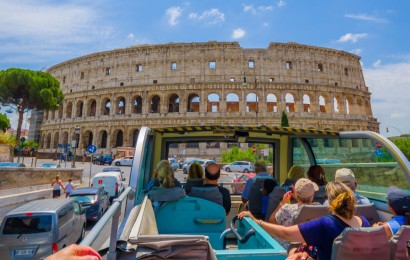A visit to the Vatican Museums is a very demanding experience and often tourists wonder what are the most famous paintings to see inside the museum.
There are many works worthy of attention during a tour to discover the Vatican Museums, we have selected some for you for a journey through history between antiquity and contemporaneity.
Brief introduction to the Vatican Museums
The Vatican Museums are the national museum of the Vatican City that houses the most important and great collections in the world accumulated over the centuries by the popes.
The Vatican Museums were founded by Pope Julius II in 1506 at the behest of Pope Clement XIV and opened to the public in the 18th century. This Pope was a great lover of the arts and it was he who asked Michelangelo to paint the vault of the Sistine Chapel, and Raphael to fresco the famous Vatican rooms. But Julius II was also responsible for the construction of the new Basilica of Saint Peter and the beautiful statue of Moses by Michelangelo.
Today, the Vatican Museums have become the second most visited museum in Europe after the Louvre Museum in Paris. And like the largest museums in the world, these are divided into different sections, depending on the historical period or the works kept.
Vatican Museums: most famous paintings
Here is the list of the most famous paintings of the Vatican Museums:
Giotto di Bondone - Stefaneschi Triptych
Not everyone knows that inside the Vatican Museums, there is also one of Giotto’s most beautiful works.
The triptych is a painting with 3 compartments, with bright colors and golden background, and which takes its name from Cardinal Jacopo Caetani of Stefaneschi and for this reason called "the Stefaneschi Polyptych".
It was he who ordered the execution for the high altar of the ancient Basilica of St. Peter but whose execution is not signed.
The painting was made between 1315 and 1320 by Giotto di Bondone and his aides. Its peculiarity is that it was painted on both sides to be seen by both the priest and the faithful:
- in the back side, are depicted Christ enthroned with Angels and Cardinal Stefaneschi, between the Crucifixion of St. Peter on the left and the Martyrdom of St. Paul on the right; in the predella below the Madonna and Child enthroned between two angels and the twelve apostles;
- on the front side facing the faithful are represented St. Peter enthroned with Cardinal Stefaneschi, who holds in his hands the model of the triptych, and Pope Celestine I in the central table and in the side tables, St. James and St. Paul on the left, St. John the Evangelist and St. Andrew on the right; only one compartment with three Saints remains of the predella.
Raphael - The Transfiguration of Christ
The Transfiguration of Christ together with the Resurrection of Lazarus by Sebastiano del Piombo, are the two paintings commissioned by Cardinal Giulio de' Medici, future Pope Clement VII, for the Cathedral of St. Giusto in Narbonne.
The Transfiguration was painted by Raphael (the last painting before his death) between 1516 and 1520, while Giulio Romano was commissioned to complete it.
The large altarpiece, however, was no longer brought to the cathedral of Narbonne, France, but in 1523 it was placed on the high altar at the church of San Pietro in Montorio in Rome. . The altarpiece depicts two episodes narrated in succession in the Gospel of Matthew: the Transfiguration on high, with Christ in glory between the prophets Moses and Elijah, and, below in the foreground, the meeting of the Apostles with the obsessed child with biased eyes who will be miraculously healed by Christ on his return from Mount Tabor.
Michelangelo Merisi da Caravaggio - The Entombment of Christ
The Deposition of Christ is considered one of Caravaggio’s best works, made between 1600 and 1604.
It was commissioned by Girolamo Vittrice for the family chapel in S. Maria in Vallicella (New Church) in Rome.
In Caravaggio’s painting, the Christ is not represented when he is lowered into the tomb, but when, in the presence of the pious women, he is laid by Nicodemus and John on the Stone of the Anointing, that is, the tombstone with which the tomb will be closed. Around the body of Christ are arranged the Virgin, Mary Magdalene, John, Nicodemus and Mary of Cleophas, who raises her arms and eyes to heaven in a gesture of very high dramatic tension.
Nicolas Poussin - The Martyrdom of St. Erasmus
The altarpiece, initially commissioned to Pietro da Cortona, passed to Poussin in 1628, who completed it within the following year, following the preparatory drawings already elaborated by Cortona. The work narrates the event of the martyrdom of Sant'Erasmo, bishop of Formia, or the evisceration suffered during the persecutions of Diocletian in 303 AD.
Benozzo Gozzoli - Madonna of the Girdle
Benozzo Gozzoli painted the Madonna della Cintola between 1450-52.
In the upper part of the painting, closer to the Angelic style, the Madonna, surrounded by angels, offers, as proof of her ascent into heaven, the belt to St. Thomas who, not having witnessed the death, burial and assumption of Mary, He would not believe what others told him about what had happened.
In the predella are illustrated episodes of the life of the Virgin (Birth, Marriage, Annunciation, Nativity of Christ, Circumcision of Jesus, Death of the Virgin) which express the great qualities of decorator of Gozzoli.

